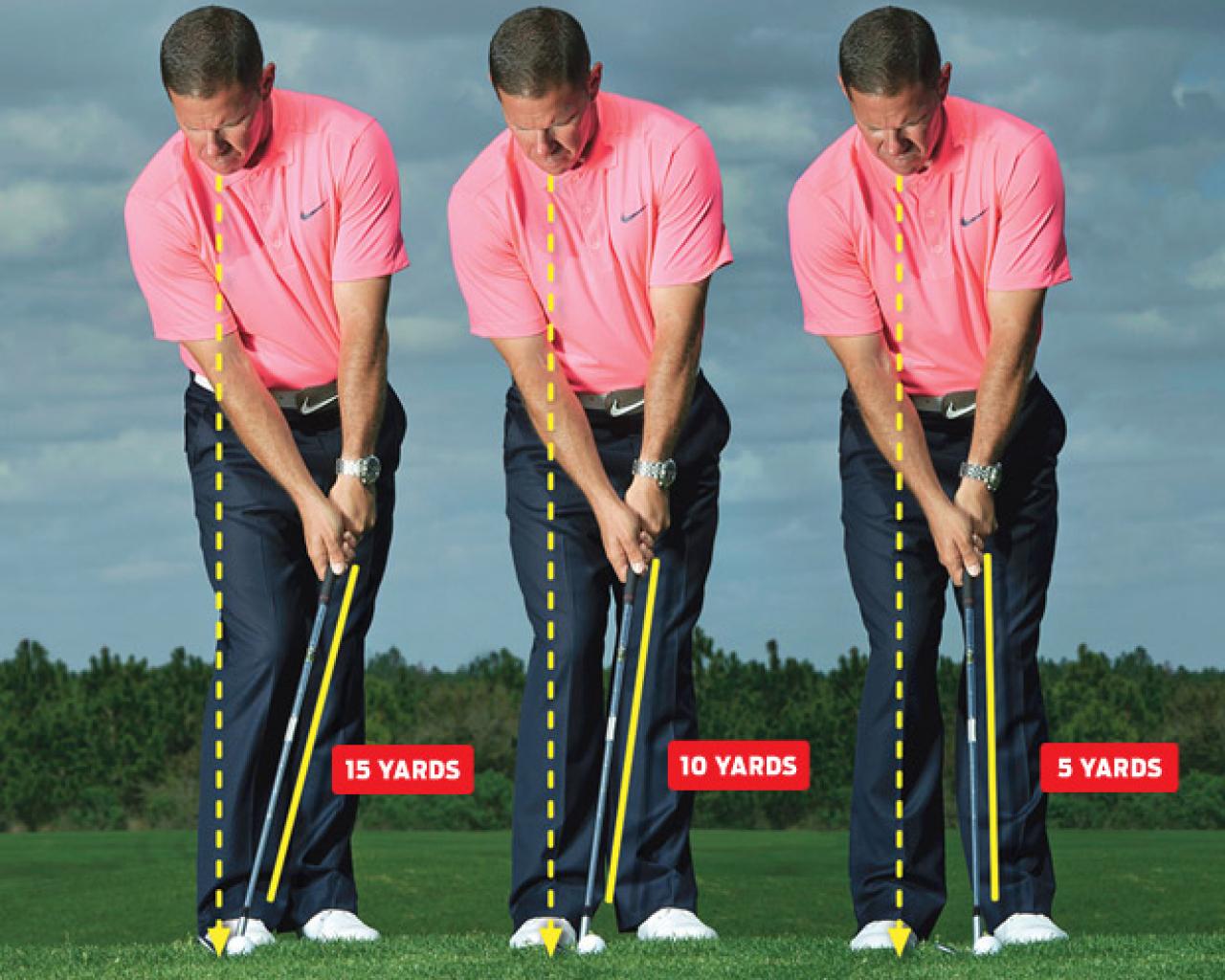To chip a golf ball, use a short, controlled swing and strike the ball with a descending blow. Position the ball back in your stance and keep your hands ahead of the clubhead.
Chipping a golf ball requires precision and control. Mastering this skill can significantly improve your short game. Proper technique ensures the ball lands softly on the green and rolls towards the hole. Focus on maintaining a stable stance and a smooth, rhythmic swing.
Keep your weight slightly forward and eyes on the ball. Practice different clubs to understand how each affects distance and roll. Consistent practice will build confidence and improve your chipping accuracy. Remember, the key is control, not power.

Credit: www.rotaryswing.com
Choosing The Right Club
Chipping a golf ball requires the right club. Selecting the correct club can improve your game. The right club can make your shot easier.
Understanding which club to use is key. The right club helps control distance and trajectory. It also helps you achieve the desired outcome.
Club Selection Tips
- Assess the Distance: Shorter shots need higher lofted clubs.
- Check the Lie: The ball’s position affects your choice.
- Consider the Terrain: Rough or smooth ground needs different clubs.
- Think About Your Skills: Use clubs you are comfortable with.
Different Clubs For Different Situations
| Situation | Recommended Club |
|---|---|
| Short Distance | Pitching Wedge |
| Medium Distance | 9-Iron or 8-Iron |
| Long Distance | 7-Iron or 6-Iron |
| Sand Trap | Sand Wedge |
| Green Approach | Gap Wedge |

Credit: www.golfdigest.com
Perfecting Your Stance
Perfecting your stance is crucial for a successful golf chip. A proper stance ensures balance and accuracy. It also helps generate consistent shots. Let’s dive into the specifics of stance improvement.
Proper Foot Placement
Foot placement is essential for a stable stance. Position your feet shoulder-width apart. This stance provides a strong foundation. Align your front foot slightly ahead of the ball. Your weight should be balanced on both feet. Slightly bend your knees for better control.
Body Alignment
Body alignment ensures your chip travels in the intended direction. Face your body parallel to the target line. Your shoulders, hips, and feet should align. Point your chest towards the ball. Ensure your eyes are focused on the ball. Keep your back straight for stability.
| Step | Description |
|---|---|
| Foot Placement | Feet shoulder-width apart, front foot ahead |
| Weight Distribution | Balance weight evenly, slight knee bend |
| Body Alignment | Align shoulders, hips, feet parallel to target |
| Focus | Eyes on the ball, chest towards the ball |
| Posture | Back straight, stable stance |
Grip Techniques
Mastering the right grip techniques is essential for chipping a golf ball. Your grip influences the control and precision of your shot. Let’s explore some effective grip techniques for chipping.
Standard Grip
The standard grip is a solid foundation for beginners. It provides stability and control. Follow these steps to execute a standard grip:
- Place the club in your left hand. Align it with your fingers, not your palm.
- Wrap your left hand around the club. Ensure the thumb points down the shaft.
- Place your right hand below your left hand. Interlock your pinky finger with your left index finger.
- Both thumbs should point down the shaft. Grip the club firmly but gently.
Alternative Grips
Different grips can offer better control for various situations. Here are some alternative grips:
| Grip Type | Description |
|---|---|
| Overlap Grip | Place the right pinky finger over the left index finger. This grip offers more control. |
| Baseball Grip | Hold the club like a baseball bat. This is great for those with smaller hands. |
| Claw Grip | Hold the club with a claw-like grip. This reduces tension in your hands. |
Each grip has its advantages. Experiment to find what works best for you. Good grip techniques are key to improving your chipping skills.
Backswing Fundamentals
Mastering the backswing is crucial for effective chipping in golf. It sets the stage for a solid and controlled shot. This section will guide you through the key elements of the backswing.
Ideal Backswing Length
The backswing length is vital for control. A shorter backswing helps with accuracy and precision. For beginners, keeping the backswing compact is best.
- Aim for a backswing that reaches your waist.
- Keep your arms relaxed.
- Maintain a slight bend in your wrists.
Practice this length to build muscle memory. It ensures consistency in your shots.
Maintaining Control
Control during the backswing is essential. Avoid fast or jerky movements. A smooth and steady motion is key.
- Start the backswing slowly.
- Focus on a smooth motion.
- Keep your eyes on the ball.
Control helps in delivering an accurate chip. It also reduces the risk of mishits.
Remember to practice regularly. Regular practice enhances your muscle memory. This leads to better control and precision in your chipping.
Executing The Downswing
Perfecting the downswing in a golf chip shot is crucial. It ensures the ball lands precisely where you want. Let’s dive into the key components of executing a flawless downswing.
Smooth Transition
A smooth transition is vital for a controlled downswing. Your body should move in harmony. Avoid sudden jerks or abrupt movements. This keeps the swing fluid and balanced.
Start by gently shifting your weight forward. This helps in maintaining a steady motion. Keep your arms relaxed and let the club follow a natural path. Practicing this can make your downswing more consistent.
Weight Transfer
Proper weight transfer is essential for a powerful downswing. Begin with your weight evenly distributed. As you swing, shift your weight to your front foot. This adds momentum to the club.
Here’s a simple breakdown:
- Start with your weight centered.
- During the backswing, slightly shift your weight to the back foot.
- As you start the downswing, move your weight to the front foot.
- Finish with most of your weight on your front foot.
This weight shift helps in generating power and ensures a clean strike on the ball. Practice these steps to enhance your downswing performance.
Ball Contact
Understanding ball contact is crucial in learning how to chip a golf ball. The right contact can make or break your shot. This guide will help you master the basics of ball contact for better chipping.
Hitting The Sweet Spot
The sweet spot is the center of the clubface. Hitting it ensures optimal ball control. Follow these steps:
- Place the ball in the center of your stance.
- Keep your weight on your front foot.
- Maintain a steady grip on the club.
- Focus on striking the ball first.
Striking the sweet spot reduces spin and increases distance. Practice this to improve your game.
Avoiding Common Mistakes
Many golfers make mistakes during chipping. Here are common errors and solutions:
| Mistake | Solution |
|---|---|
| Hitting behind the ball | Shift weight to the front foot. |
| Using wrists too much | Keep wrists firm and steady. |
| Not following through | Complete your swing naturally. |
Avoid these mistakes to enhance your chipping skills. Focus on proper ball contact for better results.
Follow-through Importance
Understanding the importance of follow-through can greatly improve your chipping game. A proper follow-through ensures that the ball travels the desired distance and direction.
Proper Finish Position
Maintaining a proper finish position is vital. Your club should point towards your target. Your wrists should stay firm, avoiding flips or breakdowns. This helps in achieving a more consistent ball flight.
Maintaining Balance
Balance is key in golf. You must keep your weight forward during the follow-through. This helps to avoid fat or thin shots. A balanced stance ensures a controlled and precise chip shot. Practice by holding your finish until the ball lands.
| Key Points | Explanation |
|---|---|
| Proper Finish Position | Club points to target, wrists firm |
| Maintaining Balance | Weight forward, controlled stance |
Practice Drills
Chipping a golf ball can be tricky, but practice makes perfect. By focusing on specific drills, you can improve your short game skills and consistency. Here are some effective practice drills to help you master chipping.
Short Game Drills
Short game drills focus on improving your precision and control. Here are some drills to try:
- Target Practice: Set up targets at various distances. Aim to land the ball near each target.
- Landing Zone Drill: Create a landing zone with tees or towels. Practice chipping the ball into this zone.
- Bunker Practice: Place balls in a bunker. Practice chipping out and landing on the green.
Consistency Exercises
Consistency exercises help you develop a reliable chipping technique. Try these exercises:
- Repetition Drills: Chip 10 balls from the same spot. Focus on hitting the same spot each time.
- Alignment Check: Use alignment sticks to ensure your stance and swing path are correct.
- One-Handed Chipping: Practice chipping with one hand. This builds feel and control.
These drills and exercises can significantly improve your chipping skills. Practice regularly and see the difference in your short game.

Credit: www.wikihow.com
Frequently Asked Questions
What Is The Proper Way To Chip A Golf Ball?
To chip a golf ball, use a narrow stance and lean slightly forward. Keep your weight on your front foot. Use a descending strike with a controlled, short backswing. Maintain a firm wrist and follow through low. Practice to improve consistency.
Do You Chip Off Your Front Or Back Foot?
Chip off the front foot. It provides better control and accuracy.
How To Get Ball In Air When Chipping?
To get the ball in the air while chipping, use an open stance and weight on the front foot. Keep hands ahead of the ball, and use a lofted club. Maintain a smooth, controlled swing.
Should I Open My Stance When Chipping?
Yes, open your stance slightly when chipping. This provides better balance and control, improving accuracy and consistency.
Conclusion
Mastering the art of chipping a golf ball can greatly improve your game. Practice regularly and focus on your technique. Use these tips to enhance accuracy and control. With dedication, your short game will become more reliable. Keep refining your skills and enjoy lower scores on the course.
Happy golfing!





